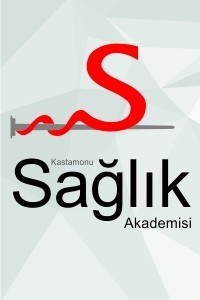Tek Merkez Deneyimi: Bening ve Malign Hematolojik Hastalarda COVID-19
Koronavirüs, Pandemi, Şiddetli akut solunum sendromu koronavirüsü 2
Single Centre Experience: Bening and Malign Hematological Patients with COVID-19
___
- Referans1: García-Suárez, J., De La Cruz, J., Cedillo, Á., Llamas, P., Duarte, R., Jiménez-Yuste, V., . . . Sánchez-Godoy, P. (2020). Impact of hematologic malignancy and type of cancer therapy on COVID-19 severity and mortality: lessons from a large population-based registry study. Journal of hematology & oncology, 13(1), 1-12.
- Referans2: Hirsch, H. H., Martino, R., Ward, K. N., Boeckh, M., Einsele, H., & Ljungman, P. (2013). Fourth European Conference on Infections in Leukaemia (ECIL-4): guidelines for diagnosis and treatment of human respiratory syncytial virus, parainfluenza virus, metapneumovirus, rhinovirus, and coronavirus. Clin Infect Dis, 56(2), 258-266. doi: 10.1093/cid/cis844
- Referans3: Mehta, V., Goel, S., Kabarriti, R., Cole, D., Goldfinger, M., Acuna-Villaorduna, A., . . . Verma, A. (2020). Case Fatality Rate of Cancer Patients with COVID-19 in a New York Hospital System. Cancer Discov, 10(7), 935-941. doi: 10.1158/2159-8290.cd-20-0516
- Referans4: Meng, Y., Lu, W., Guo, E., Liu, J., Yang, B., Wu, P., . . . Li, F. (2020). Cancer history is an independent risk factor for mortality in hospitalized COVID-19 patients: a propensity score-matched analysis. Journal of hematology & oncology, 13(1), 1-11.
- Referans5: Passamonti, F., Cattaneo, C., Arcaini, L., Bruna, R., Cavo, M., Merli, F., . . . Della Porta, M. G. (2020). Clinical characteristics and risk factors associated with COVID-19 severity in patients with haematological malignancies in Italy: a retrospective, multicentre, cohort study. The Lancet Haematology, 7(10), e737-e745.
- Referans6: Rate, C.-F. (2020). Characteristics of Patients Dying in Relation to COVID-19 in Italy Onder G, Rezza G, Brusaferro S. JAMA. Published online March, 23. Wang, C., Horby, P. W., Hayden, F. G., & Gao, G. F. (2020). A novel coronavirus outbreak of global health concern. The lancet, 395(10223), 470-473.
- Referans7: Wiersinga, W. J., Rhodes, A., Cheng, A. C., Peacock, S. J., & Prescott, H. C. (2020). Pathophysiology, transmission, diagnosis, and treatment of coronavirus disease 2019 (COVID-19): a review. Jama, 324(8), 782-793.
- Referans8: Wood, W. A., Neuberg, D. S., Thompson, J. C., Tallman, M. S., Sekeres, M. A., Sehn, L. H., . . . Niemeyer, C. M. (2020). Outcomes of patients with hematologic malignancies and COVID-19: a report from the ASH Research Collaborative Data Hub. Blood advances, 4(23), 5966-5975.
- Referans9: Yang, J., Zheng, Y., Gou, X., Pu, K., Chen, Z., Guo, Q., . . . Zhou, Y. (2020). Prevalence of comorbidities and its effects in patients infected with SARS-CoV-2: a systematic review and meta-analysis. International Journal of Infectious Diseases, 94, 91-95.
- Referans10: Zhu, N., Zhang, D., Wang, W., Li, X., Yang, B., Song, J., . . . Lu, R. (2020). A novel coronavirus from patients with pneumonia in China, 2019. New England journal of medicine.
- Yayın Aralığı: Yılda 3 Sayı
- Başlangıç: 2016
- Yayıncı: Esra DEMİRARSLAN
Covid-19 Süreci ve Hemşirelerde Oluşturduğu Yalnızlık
Covid 19 Sınırlandırılmalarının Kadına Yönelik Aile İçi Şiddet Üzerine Etkisi: Literatür Taraması
Victoria FACİN, Andréa SANCHEZ, Camille MEDEİROS, Fabiana ORLANDİ, Munik MORENO, Larissa CORDEİRO
TERSİYER BİR MERKEZİN GEBE POPULASYONDA COVİD-19 DENEYİMİ VE LİTERATÜRÜN GÖZDEN GEÇİRİLMESİ
Burcu TİMUR, Bergen LALELİ KOÇ, Hakan TİMUR
COVID 19 Hastalarında Folat, B12 ve Demir Düzeyleri Gözlemsel Vaka Kontrol Çalışması
Ahmet DOĞAN, İsmail ANAÇ, Yakup GEZER, Burcu TİMUR
Nilgün ULUTAŞDEMİR, Hakan TİMUR, Sevda UZUN, Nurşen KULAKAÇ
COVID-19 Zamanlarında Sağlık Çalışanlarının Ruh Sağlığı
GEBELİK VE GEBELİK SONRASI DÖNEMDE YENİ KORONA VİRÜSÜ HASTALIĞI (COVİD-19)
Covid 19 Salgınında Nomofobi ve Psikolojik Sağlamlığın Bazı Değişkenlere Göre İncelenmesi
